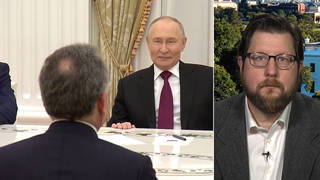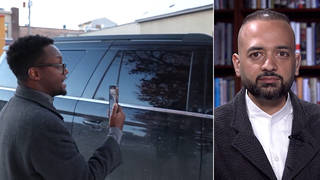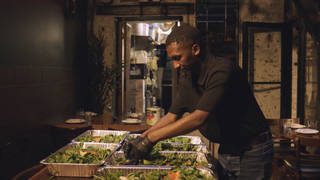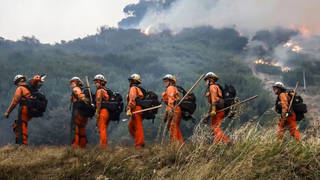
Guests
- Don Hankinspyrogeographer and Plains Miwok fire expert who teaches at California State University, Chico.
We examine California’s history of forest management and how a century of fire suppression has made the current climate fires even more destructive. For thousands of years, Native American tribes in California would regularly burn the landscape to steward the land, but colonization led to the suppression of these tactics and decades of misguided policy. A return to these Indigenous practices could help better steward the land and foster greater climate resiliency, says Don Hankins, a pyrogeographer and Plains Miwok fire expert who teaches geography and planning at California State University, Chico. “If we all work together and we use the same mindset in terms of process, being able to use fire within the landscape, we can start to put fire back in at the scale that it needs to be for the right ecological and cultural purposes,” Hankins says.
Transcript
AMY GOODMAN: We turn to the West Coast, where wildfires fueled by the climate crisis have burned more than 5 million acres, darkened the skies from Canada to Mexico with smoke and ash. As nearly 90 wildfires burn, Portland marked the worst air quality of any major city in the world Monday, with San Francisco, Seattle and Los Angeles not far behind. Hazy conditions from the fires has spread as far as New York and Washington, D.C. The fires have killed at least 35 people, forced mass evacuations — dozens are missing — laid bare the reality of the changing climate. But, on Monday, President Trump continued to deny the climate crisis in an exchange with California’s Natural Resources Secretary Wade Crowfoot.
WADE CROWFOOT: If we ignore that science and sort of put our head in the sand and think it’s all about vegetation management, we’re not going to succeed together protecting Californians.
PRESIDENT DONALD TRUMP: OK. It’ll start getting cooler. You just —
WADE CROWFOOT: I wish —
PRESIDENT DONALD TRUMP: You just watch.
WADE CROWFOOT: I wish science agreed with you.
PRESIDENT DONALD TRUMP: I — well, I don’t think science knows, actually.
AMY GOODMAN: “I don’t think science knows, actually,” Trump said. Well, California Governor Gavin Newsom also addressed President Trump, who has repeatedly blamed the fires in California on forest management.
GOV. GAVIN NEWSOM: There’s no question, when you look past this decade, looking past almost a thousand-plus years, that we have not done justice on our forest management. I don’t think anyone disputes that. …
And final point, I’d be negligent — now, this is not — and we’ve known each other too long, and, as you suggest, the working relationship, I value. We obviously feel very strongly that the hots are getting hotter, the dries are getting drier. When we’re having heat domes the likes of which we’ve never seen in our history, the hottest August ever in the history of the state, the ferocity of these fires, the drought five-plus years, losing 163 million trees to that drought, something has happened to the plumbing of the world. And we come from a perspective, humbly, where we submit the science is in, and observed evidence is self-evident, that climate change is real, and that is exacerbating this.
AMY GOODMAN: Governor Newsom said 57% of California’s forests are on federal land, compared to just 3% that is owned by California, the rest privately owned.
Well, today we look at California’s history of forest management and how a century of fire suppression has made the current climate fires even more destructive. Fire is a natural part of life in California. For thousands of years, Native American tribes would regularly burn the landscape to steward the land. But colonization led to the suppression of these tactics and decades of misguided policy.
For more on this history and how a return to Indigenous stewardship of the land could foster greater climate resiliency, we go to Chico, California, where we’re joined by Don Hankins, a pyrogeographer and Plains Miwok fire expert. He is a professor of geography and planning at California State University, Chico.
Welcome to Democracy Now! It’s great to have you with us, Professor Hankins. Can you talk about what’s happening in California now, Trump saying it’s just two words, it’s forest management, and then Gavin Newsom saying, “Yeah, we also have to weigh climate change in this, but forest management is a major issue,” Professor Hankins?
DON HANKINS: Right, yeah. Good morning, Amy and Juan. Yeah, I think the situation in California at present, we have over 3 million acres ablaze over a very short period of time. And I think that the political jargon that’s being pushed around right now is really an unfortunate situation, given the situation in the state. There’s aspects of both, what the president and the governor are saying, are definitely correct. It’s not just a one-piece solution. Forest management is definitely a part of the problem, although climate change is something that’s happening, and we have to recognize that.
So, when we think about what’s going on in our region, particularly throughout the state of California and the West Coast at this point, we have prolonged drought. The governor mentioned five years; I would say that it’s at least going on 20 years of drought. We’ve had some punctuated time periods with some rain that has come in, like 2017 and 2018, but the rain that we have is not enough to saturate the ground and allow for the groundwater recharge that is so important for our landscape to thrive and be healthy. And then, when we add to that the accumulation of fuels within that landscape and so forth, and the inability to put fire at the scale that it really needs to be, it is such a huge part of this problem.
JUAN GONZÁLEZ: And, Professor Hankins, could you talk about the — if you can, about the difference between federal policies, on the federally owned lands, and state policies? Because, after all, as Governor Newsom mentioned, most of the forest land is federal land. In fact, almost half of all of California is federally owned land, and 53% of Oregon is federally owned land. How is the federal government dealing with its own policies of managing these forests?
DON HANKINS: Right. Well, that’s a really interesting question. So, when we think about that ownership, when we talk about like state ownership of land, that state ownership is not really owned by the state, but a lot of that’s privately owned land. So, you know, a lot of rural communities, we have a lot of different landowners who are there on those lands. And within the state’s fire responsibility, what we call the state responsibility area, the SRA, CAL FIRE, under the Department of Forestry and Fire Protection, is that entity that has the ability to steward over it. On the federal lands, obviously, Forest Service, National Park Service, Bureau of Land Management, etc., all are part of that piece.
And there’s different policies in terms of the way that fire is allowed to be used in those places. So, when we think about the federal fire policy aspect, the National Wildland Coordinating Group and other entities within the federal government allow for the integration of policies. And so, some of those policies include let-burn policies and allow for wildland fire use, whereas within the state, when fires happen, CAL FIRE is mandated to put those fires out. So, those are some of the differences that are there between those areas.
But I think the bottom line is really coming down to the amount of acreage that we’re allowed to see burn on an annual basis, but then also how much money is being put into those efforts. And I would say it’s pretty minuscule. For instance, when we think about what the targets were for the Forest Service within this particular time frame of this year, I want to say it was about a half-million acres, so 500,000 acres of land. Obviously, with these fires, we have 3 million acres currently burning, or more. But nowhere are we getting close to the scale of being able to put the type of fires that historically have occurred within this landscape back into this landscape to mitigate the effects of climate change and make the landscape more resilient.
JUAN GONZÁLEZ: And could you talk about the history of fire suppression as a tool of colonization? There was a piece in The Guardian where journalist Susan Cagle wrote, quote, “The Spanish were the first California colonizers to prevent indigenous people from burning the land. In 1850, the US government passed the Act for the Government and Protection of Indians, which outlawed intentional burning in California even before it was a state.”
DON HANKINS: Right. Those are huge policies. When we think about the early Spanish colonization in California beginning in 1769, we have missions that are established along the California coast, and those missions had very specific policies that were put down by the Spanish governor of California that forbade people from setting fires. The Spaniards were not accustomed to the idea of Indigenous people burning. They saw it as a risk to their infrastructure and their way of life. And so, that then put really harsh penalties, upwards of death, to Indian people who were setting fires. And that is a way of life. That is a way that people have lived in this landscape for millennia. And that tool began to be removed from the tool box of Native people.
And then, when we add to the American colonization, as you point out, 1850 — the state hadn’t even really become a state yet — we had policies within the state that also forbid the use of fire by Indigenous populations, and the same kinds of penalties were applied. So, reluctantly, you know, people would not, obviously, be able to set fires if their life was on the line for it. And so we see a real decline in the use of fire, and the inability for people to access land to tend to those, which had gone on for many thousands of years, through past climate change events.
AMY GOODMAN: So, what has to happen right now, Professor Hankins? And talk about your own family, from the Delta area, from the San Francisco Bay Area, how you’ve seen the land change with regard to stewardship, and what you want to see happen.
DON HANKINS: Right. Well, I think what we need to see happen at this point is the ability for Indigenous practitioners, working with others — you know, it’s not just Indigenous people that are able to do this. We have 40 million people living in the state. There’s only, you know, one, one-and-a-half or so percent of the state’s population is Indigenous, or Native American, I should say, based on identification. We have a lot of people from out of the state, too. But I think it’s important that if we all work together and we use the same mindset in terms of process, being able to use fire within the landscape, we can start to put fire back in at the scale that it needs to be for the right ecological and cultural purposes within the landscape to create the same outcomes. And I think the process is a really big part of that.
So, when we ask the question of, well, you know, “How can we restore the landscape back to what it was, say, in 1769 or 1850?” that’s not what I’m asking for. That’s not what I think needs to happen. What I say is that we — you know, climate change does happen, and the ecosystems that are here at present have a relationship with fire. And so, if we put that same type of fire that those systems had evolved in back into them and we’re stewarding them in the exact same way, then we’re able to ensure that climate resiliency in those landscapes, but also ensure the biodiversity, the carbon capture and all the other attributes of what we maybe call ecosystem services as part of that, to make those beneficial.
So, in terms of the Delta region in San Francisco Bay Area, for instance, we have a lot of landscape change that has happened. We’ve got a lot of areas under that time period of 1850 to the present that was turned under the plow. So, wetlands, riparian forest, emergent marshes, grasslands, vernal pools, chaparral ecosystems, they all are part of those landscapes, but a lot of those places have been very heavily impacted.
So, one thing that I particularly focus in on in my research is how we can use fire as a conservation tool, which is part of that Indigenous set of ways of burning. And when we think about, like, California’s valued woodlands, where there’s only like 2% remaining throughout the entire state, that’s an endangered ecosystem. And with small pockets of 100 acres here or 200 acres there, if fire gets into those places, we lose the diversity of those forests. We lose those forests, and we lose the carbon that’s captured in them. So, those are the places that I tend to focus in on in a lot of my work, but that work also then extends from those wetland areas all the way to the tops of the Sierras and the mountains that feed into the system. So, it’s an interconnected and interrelated relationship with fire.
AMY GOODMAN: Well, we want to thank you so much for joining us. And personally, I mean, how are you dealing with the massive — well, right now the pollution in the air? You have Los Angeles, San Francisco, Portland, Seattle, the worst air in a major city in the world. And especially the Native American tribes, what are people doing on the ground?
DON HANKINS: Yeah. Well, it’s a lot of people having to stay indoors at this point. I will say that on my drive down to Chico this morning, I was happy to look up and see the stars. So, the constellations are out there. But I will also point out that within our Native ways of thinking about it, there’s benefits to smoke that we have to be aware of, as well. That includes fumigation. That includes cooling of our streams for salmon, and other things like that. So, while we are dealing with a very toxic load of smoke right now, this is not what our Indigenous fires would have created. This would have been spread throughout the year. So, I think, as a society, we need to get used to a little bit of smoke, but not the level of smoke that we’re experiencing right now, and hopefully never get to this toxic level again.
AMY GOODMAN: Professor Hankins, we want to thank you for being with us. We want to say we also asked a scientist with the U.S. Forest Service to join us on the program, but they were told by the Forest Service they could not. They were told this by the Washington office. Don Hankins, pyrogeographer, Plains Miwok fire expert, professor of geography and planning at California State University, Chico, where he’s speaking to us from.
When we come back, as Amazon CEO Jeff Bezos becomes the first person in the world to be worth $200 billion, we look at how Amazon has gouged people during the pandemic, up to 1,000%. Stay with us.












Media Options